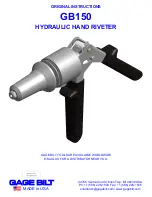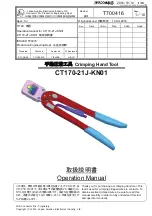
-29-
7.4
Clamping force with moist timber (green timber)
It is possible to anticipate the shrinkage of fresh timber and thus influence the clamping force of the joint. In this
case it is sufficient to increase the clamping force (see "K" value above). If the timber is stored for a few
days/weeks, the moisture content of the timber decreases and the joint can be more easily assembled flush
during the installation on site.
7.5
Dry timber exposed to the weather
If the joints are made of dry timber (glued laminated timber, beams of two or three layers of dry timber, etc.),
the material must be covered when stored outdoors or exposed to the weather. The assembly of joints that
have expanded under the influence of moisture can prove difficult or even impossible.
8
Troubleshooting
Danger
Determining the causes for existing defects and eliminating these always requires
increased attention and caution.
If the machine switches off automatically, the electronic system has activated self-protection mode.
Despite this protective function, overload and as a consequence damage to the machine may occur during
certain applications.
Some of the most frequent defects and their causes are listed in the following chart. If case of other defects,
please contact your dealer or the MAFELL customer service.
Defect
Cause
Remedy
The joint has too much play: the pin
sits too loosely in the pin socket.
The clamping force of the joint is
inadequate.
Increase the distance (+) between
the cutter and the router base
plate (Chapter 7.2: Adjusting the
clamping force).
The joint is too tight: it is too difficult
to insert the pin in the pin socket.
The clamping force of the joint is
too high. The pin is jammed and
cannot be driven in flush.
Decrease the distance (-)
between the cutter and the router
base
plate
(Chapter
7.2:
Adjusting the clamping force).
The pin is difficult to insert and
seems to jam in the pin socket.
The pin and/or the pin socket
have irregularities on the milled
surfaces.
Cut the pin or pin socket a
second time, this time pressing
the guide ring of the router
correctly against the jig. (Chapter
6.6. and 6.7.)
The pin is not sitting flush in the pin
socket.
The stop of the male and/or
female jig did not rest properly on
the timbers.
Make sure that the stops are
always carefully positioned.
The router vibrates intensely, it is
not possible to produce a suitable
joint.
The guide ring is no longer
perfectly round and/or the cutter
no longer runs concentrically
and/or the conical adapter has
suffered an impact.
Replace the damaged parts and
start a new attempt.
















































